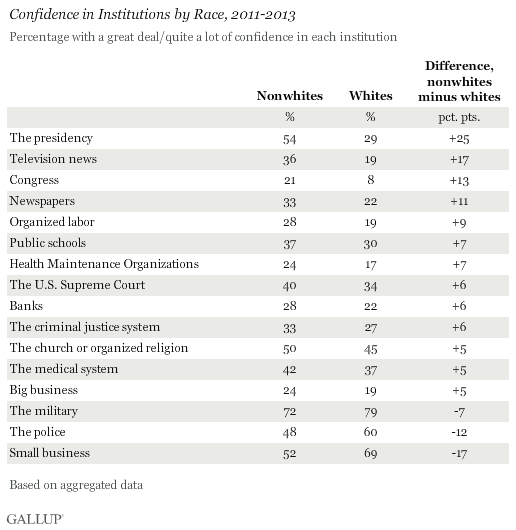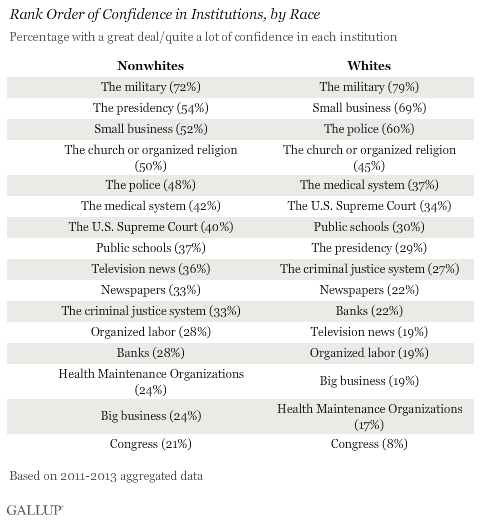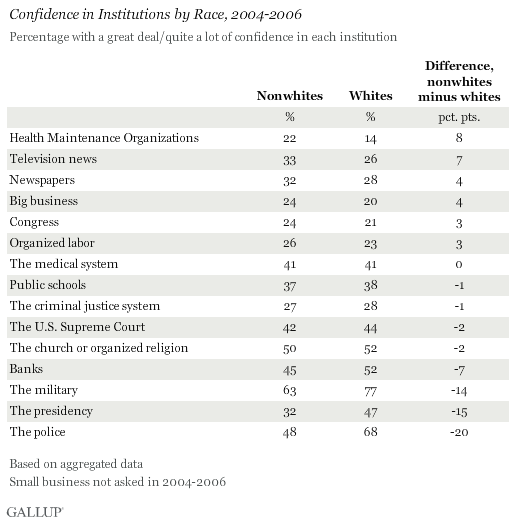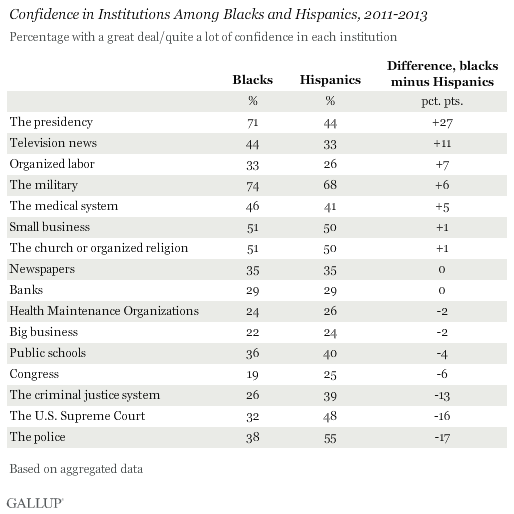PRINCETON, NJ -- U.S. nonwhites express greater confidence than whites in most major institutions in the country, particularly the presidency, television news, and Congress. Whites are more confident than nonwhites in the military, the police, and small business.

These results are based on aggregated data from Gallup's 2011-2013 Confidence in Institutions polls, which allow for sufficiently large samples of racial and ethnic minorities to provide meaningful estimates.
In general, though, the differences by race are not large enough to dramatically alter the rank order of confidence in institutions for whites versus nonwhites. Both whites and nonwhites express the greatest confidence in the military and the least in Congress, with small business and the police in the top five for each group. The biggest difference in relative rank order is for the presidency, which is near the top of the list for nonwhites, but more middle-of-the-pack for whites.

Barack Obama's status as the first black president helps explain the large racial difference in confidence in the presidency. Minorities also appear to be more trusting than whites of the news media, although on an absolute basis, nonwhites do not have a great deal of confidence in either newspapers or television news.
Some of the racial differences, such as confidence in news media, police, small business, and the military may be a function of political differences between nonwhites -- who tend to be more Democratic politically -- and whites, who are more likely to be Republican.
In fact, nonwhites' greater confidence in most U.S. institutions today may largely be due to political differences stemming from the fact that the current president is a Democrat. Across 15 institutions measured in both 2004-2006 and 2011-2013, nonwhites' confidence has increased two points, on average. Meanwhile, whites' average confidence has dropped seven points, indicating today's racial differences are fueled mostly by declining white confidence in U.S. institutions.
Prior to the recent decline, whites were at least as confident as nonwhites in many institutions, and the white-nonwhite differences were relatively modest in most circumstances.
As is true now, whites in 2004-2006 were also significantly more likely than nonwhites to say they were confident in the military and the police. At that time, not surprisingly, whites were much more confident than nonwhites in the presidency.

Blacks, Hispanics Rate Most Institutions Similarly
The two largest racial and ethnic minority groups in the U.S. -- Hispanics and blacks -- currently rate most institutions similarly. They differ most in their confidence in the presidency, with 71% of blacks and 44% of Hispanics expressing confidence.
In contrast, Hispanics are more confident than blacks in the police, the Supreme Court, and the criminal justice system. That may be an outgrowth of a long history of real and perceived discrimination against blacks by the police and U.S. legal system, which Hispanics may not share.

Blacks and Hispanics each express high levels of confidence in the military and low confidence in Congress and big business. Blacks are nearly as confident in the presidency as in the military.
Implications
Nonwhites and whites typically differ in their levels of confidence in the military and the police, with whites more confident in both of those institutions. However, nonwhites currently have more confidence in most other major U.S. institutions, but that is not necessarily typical.
The party of the president has a profound impact on Americans' confidence in the institution of the presidency, and likely perceptible but less notable effects on confidence in a number of other institutions. Thus, confidence in most U.S. institutions could drop among nonwhites, while whites' confidence could grow, if a Republican succeeds Obama as president -- which would have the effect of erasing many of the current racial differences.
Survey Methods
Results for this Gallup poll are based on aggregated telephone interviews conducted June 2011, June 2012 and June 2013, with a random sample of 3,553 adults, aged 18 and older, living in all 50 U.S. states and the District of Columbia.
For results based on the total sample of national adults, one can say with 95% confidence that the margin of sampling error is ±2 percentage points.
For results based on the sample of 2,826 non-Hispanic whites, the margin of sampling error is ±2 percentage points.
For results based on the sample of 651 nonwhites, the margin of sampling error is ±5 percentage points.
For results based on the sample of 296 non-Hispanic blacks, the margin of sampling error is ±7 percentage points.
For results based on the sample of 245 Hispanics, the margin of sampling error is ±7 percentage points.
In addition to sampling error, question wording and practical difficulties in conducting surveys can introduce error or bias into the findings of public opinion polls.
For more details on Gallup's polling methodology, visit www.gallup.com.

